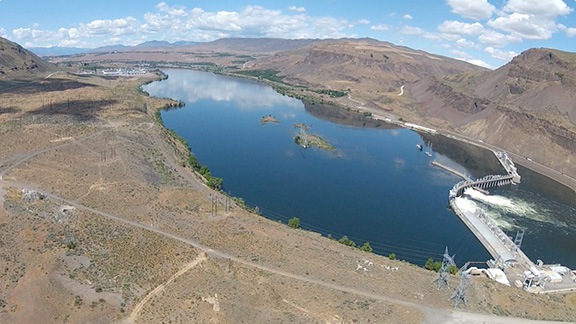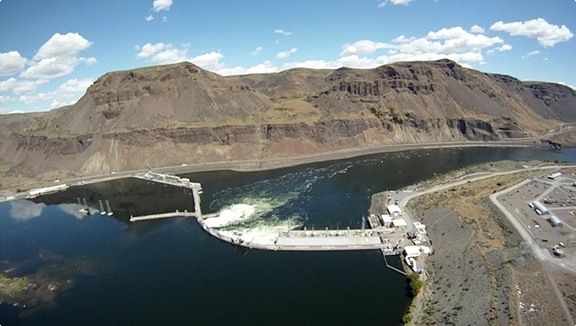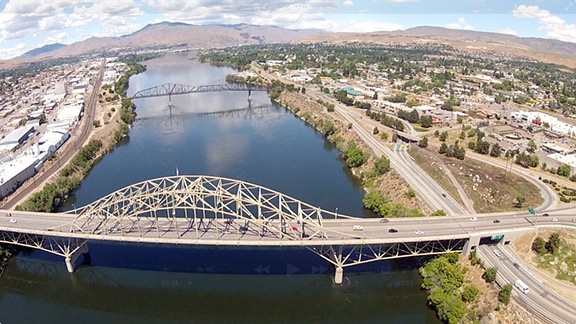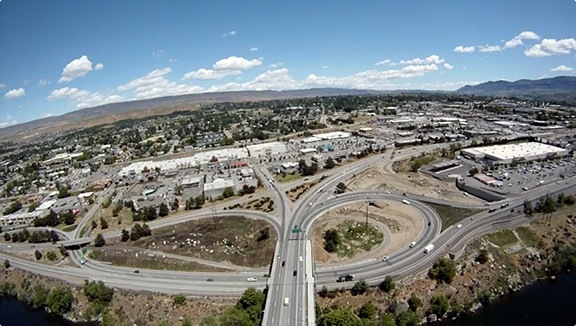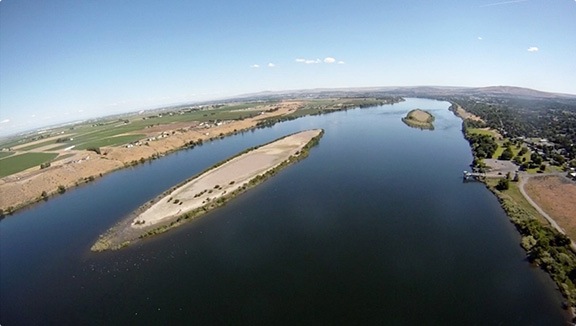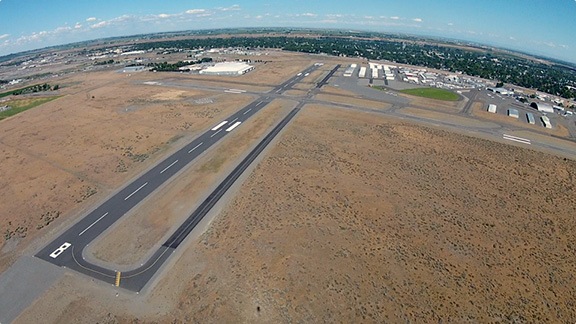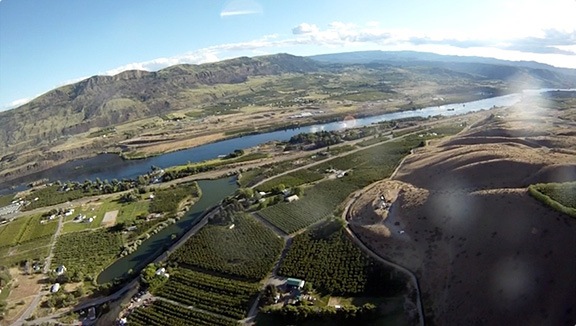Be careful what you wish for.
I’ll admit it: when I’m on contract to dry cherries, I hope for rain.
Yes, I’m in Washington state. But no, it doesn’t usually rain much here. I’m on the east side of the Cascade Mountains. That’s the dry, desert side.
In past years, rain has been light. I could count the number of days I had to fly on the fingers of one hand. Last year, I think I went to the second hand. We had one brutal day when I flew more than 6 hours last year, flying over one orchard after another until every single one under contract had been dried. But there isn’t usually much rain.
And although I do get paid to sit around and wait for the rain — which sometimes requires me to sit around my base all day watching radar — I also get paid to fly. It’s the combination of the two forms of revenue that make the season worthwhile.
So I hope for rain.
This week, however, I got more than I wanted. A lot more.
Day One
It started on Monday. I was still based in Quincy, so when the call came at 4:15 AM, it seemed to make sense for me to get started on the 50-acre orchard north of town. But radar showed activity in the Wenatchee area where I had other orchards under contract. I decided to call my other pilot, Mike, who was two spots down from me in the RV park. If I got called to Wenatchee, he’d have to do all the drying in Quincy.
Of course, I woke him up. But that’s part of the job. Our daily standby pay guarantees that we’ll be ready to fly from first light to last light. In Washington, in the summer, that’s a 17-hour day.
It was a good thing I called Mike because I’d been flying only 20 minutes when the call came to dry my first orchard in Malaga. Mike was enroute to the Quincy orchard when I left, telling him to start where I’d left off: at the first wind machine on the west end moving east.
I dried 26 acres in two orchards in Malaga and Wenatchee Heights. Then I returned to Quincy to dry 32 acres in two orchards there with a refueling in between. Then back to Malaga, Monitor, and Wenatchee Heights — multiple times — to dry a total of 177 acres in five orchards, one of which I dried four times.
It rained all day long, barely stopping long enough for us to get in and fly before the rain started up again.
I say “us” because I wasn’t the only helicopter flying. There was at least a dozen of us — R44s, JetRangers, Hughes/MD 500s, Hillers, and even a big, fat Huey. We were darting all over the place, making position calls on the informal air-to-air frequency, 123.45.
For the most part, pilots were polite and informative to avoid traffic conflicts, but there were exceptions. When one jackass flew 50 feet over the top of me while I was hovering at treetop level in an orchard in Malaga, I slammed him over the radio to make it clear that such behavior simply wouldn’t be tolerated. I don’t know whether he was being dumb or inconsiderate or simply trying to piss off the only female pilot drying cherries this year. But as anyone who knows me well can tell you, I don’t take bullshit from anyone. If I’d met him later in the day at the FBO, I probably would have attempted to break his nose — I was that pissed off.
I finished up long after sunset, when there was barely enough light to get back to my Quincy base. I’d spent 8.5 hours in the air, including all repositioning time. I’d dried a total of 245 acres of cherry trees.
What a day!
Back at my base, Mike’s wife had dinner on the table for me. Mike had spent a lot of the day flying, too, but not nearly as much as me. He’d already eaten but kept me company — and joined me to eat some of the ribs leftover from the day before — while I ate. I was exhausted when I went to bed.
But the forecast hinted that there would be more the next day.
Day 2
Although I really expected to be called out very early in the morning, I didn’t do my first dry until after 7 AM. The calls came in one after the other, evenly spaced apart. 7 acres in Malaga, 19 acres on Wenatchee Heights, 35 acres up Squilchuck Canyon, 35 acres in Monitor, 23 acres in Malaga, 7 acres in Malaga (again), and 35 acres in Monitor (again). Along the way, I refueled twice at Wenatchee Airport. I even had enough time to order, take delivery of, and eat a pizza.
In the meantime, a friend of mine in Quincy called to say that there was a bee swarm in a tree in her yard. She knew I wanted to catch it — that’s why she called me. But I was stuck in the Wenatchee area until there was no chance of rain there. I told her I’d come as soon as I could.

For a while, I just sat up at my future home and watched the storms move through Wenatchee.
I got called out to do that 35 acres in Monitor again after lunch. When that was done, it wasn’t clear whether I’d have to do any more drying. I had plenty of fuel on board and I was sick of hanging out at the airport, so I flew up to that lot in Malaga that I plan to buy, landed, shut down, and spent about an hour sitting on the best view spot just watching the world around me. It was very restful.
After about 45 minutes, I figured I was done for the day so I started up again and headed back toward Quincy. I’d gotten as far as the Rock Island dam when my phone rang. It was a client. I made a big, sweeping turn at 110 knots and headed back to dry that 35 acres in Monitor (again).
By the time I was done, it was after 5 PM. Mike had called to let me know that we’d been invited to go out for dinner (and possibly drinks) with another pilot and his grower clients in Quincy. And I still had that bee swarm to catch. And I needed a shower. Desperately.
I headed back to Quincy.
By 7 PM, I’d caught the bee swarm, showered, and was sitting down with new friends in the Moose Lodge (really!) in Quincy WA.
It was 8:30 when a grower in East Wenatchee called me. He was not one of my clients, although I’d tried at least twice to sign him up. He preferred to hang around at the airport and make friends with the pilots so he could convince them to dry his trees off contract. That made it possible for him to avoid paying standby fees. He had apparently been successful doing this for several years.
But that evening, he was in dire straits. It had rained again in Wenatchee and his orchard was soaked. And he couldn’t find any pilot to come — they were all busy drying orchards under contract. (That’s why growers contract with us. Duh.) He seemed to think I might be flying in the area and could squeeze him in. I told him I was in Quincy and done for the night. He hinted that he might want to get on contract with me. I told him I was already at capacity for both of my ships. I told him that if he’d contacted me earlier, I might have been able to add another ship and pilot and cover him under contract. I told him it was too late to launch from Quincy anyway. (For the record, I would have launched right up until 8:45 for a client under contract; sunset was about 9 PM that night.)
When I hung up, I felt bad for him, but also kind of glad that he was being taught a valuable lesson. But I discovered that he found another pilot to dry for him after all — probably first thing in the morning. (Some of the pilots need to be taught a lesson, too.)
Total for the day: 196 acres, 5.7 hours of flight time.
Day 3
I was awake the next morning at 3:51 AM when I got a text from one of my clients telling me to dry all four of his orchards in the Wenatchee area. It had rained overnight and he needed them dry before the sun hit them.

I used GPS track on my phone to show exactly where I flew on Wednesday morning. I started in Quincy, went to Monitor, then Malaga, then Wenatchee Height. Then I refueled at the airport, dried an orchard up Squilchuck Canyon, and returned direct to Quincy. 112 total miles.
I texted him back and told him I’d be at the first orchard at 4:45 AM. Of course, I was still in bed when I texted this. And the orchard was 30 nautical miles away — the farthest one. And it was still dark out.
I got up, made coffee in a travel mug, and pulled on my flight suit while Penny was out doing her business. Then I lifted Penny back into her bed, pulled the cover off Alex the Bird, grabbed my coffee, and headed out.
I preflighted with a flashlight and had the engine running by the time the horizon became clear. I took off and flew a semi-direct course. I was hovering over the first row of rainier cherry trees on the east side of the orchard at exactly 4:45. That simply amazed me.
Nice sunrise, too. A thin layer of stratus clouds kept the area shaded but glowed pink as the sun rose.
I was over the second orchard when I called Mike to let him know I was flying already. He flew later that morning in Quincy.
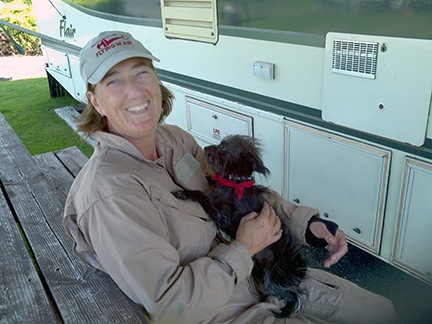
Cheryl snapped this photo of me in my flight suit with Penny shortly after my return from flying.
It was a quiet day — just the four orchards totaling 96 acres. I was done before 9 AM and after refueling, went back to Quincy. I spent the rest of the day packing my my RV in preparation for moving it to Wenatchee Heights for the rest of the season. Unfortunately, my next door neighbor had parked in such a way that I couldn’t hook up my pickup truck to the trailer. So I had to wait until 5:30 to leave. It was mostly sunny most of the day in Quincy and kind of hot and humid. I ran the air conditioning for a while.
At 6 PM, Mike, his wife Cheryl, and I headed to Wenatchee Heights. Mike was driving my truck and trailer. Cheryl was driving my Jeep towing my boat. (Mike and his replacement guy Ron are using the Jeep while they’re working for me.) And I flew up in the helicopter. I beat them there (of course) and was visited by neighbors I hadn’t seen since the previous season. Then they arrived and we parked the trailers. They drove off in the Jeep and I started settling in.
I left in the truck at 8 PM to go back to Quincy and pick up the things I’d left behind: my kayak, my Traeger grill, some nice wood palettes I’d been collecting, and my captured bee swarm, which had been flying around its temporary home all day. I’d gotten as far as Rock Island by 8:20 when my phone rang. Could I dry that orchard up on Wenatchee Heights?
If I’d been at my base — where technically, I should have been while on standby — the answer was yes. So even though I had to drive 20 minutes to get back to the helicopter and that would make it very late indeed, the answer was still yes. I turned around and drove, calling Mike along the way to let him know I wouldn’t make it there that night.
At 9 PM, right around sunset, I was hovering over the last 19 acres I’d dry that day. I was on the ground at my new base, only 2-1/2 miles away, by 9:30 PM.
Total for the day: only 115 acres in 3.6 hours, at least 1 hour of which was (non-billable) repositioning time.
Day 4
By Wednesday night, I thought the drying flights were over. There was a very slight chance of rain the next day — only 20% — when I went to bed. After years of watching weather here, I can tell you that 20% is barely worth thinking about.
So imagine my surprise when I got a call at 4:54 AM from a grower telling me that it was raining in Monitor and he’d likely need me when it stopped.
I got out of bed, made my coffee, took care of my critters, and suited up. The call to dry came at 5:45 AM from a different grower in Malaga. And that’s when the fun began.

For a while, the orchard I was waiting to dry had a cloud sitting right on it.
For the next few hours, I dried six different orchards — two of them twice — stopping only to wait out another rain storm and to refuel. It got intense for a while: while I was drying the third orchard, I had my next two orchards lined up and waiting for me. But everyone stayed calm, including me, and it got done timely. Indeed, after finishing all my orchards at around 11:30 AM, I saw other pilots heading out to start drying other ones near mine.
I waited at my base in Wenatchee Heights for rainstorm to pass through the area. This nosecam video clip shows my minute-long “commute” from my base to the orchard I dried across Squilchuck Canyon. There were lots of low clouds that morning.
Total 162 acres in 4 hours of flight time.
I was finally able to retrieve my possessions (including bees) in Quincy that evening.
Enough Already!
You know what they say: be careful what you wish for. This past week was a real lesson in that.
All cherry drying pilots want it to rain. Rain = money. But how many of us want it to rain this much?
I certainly don’t.
There comes a point where there’s so much rain that helicopters simply can’t keep the cherries dry enough to prevent splitting. I’ve heard loss numbers ranging from 10% to 50% in orchards that do have helicopters on contract. (This is better than another grower I’m in touch with who doesn’t use helicopters and had 60% splits; he’s not picking at all.) I’d also heard that loss rates were so bad in Mattawa (south of me) that growers gave up and stopped calling helicopters to dry. That doesn’t do us any good at all.
And while it’s nice to be able to send out invoices, I admit that I felt bad for my clients when I sent out the ones for this week. When you have a 35 acre orchard that needs to be dried multiple times in a day multiple times in a week, the costs climb quickly. Yes, that’s revenue for me. But it’s also a huge cost for the grower. While my services will make the difference between a crop that can be picked and sold and one that’ll rot on the trees, it must be painful for them to face such large bills.
But most of all was the sheer exhaustion I felt after hours of hovering at treetop level over fruit trees — especially the ones in orchards planted in steep terrain with numerous obstacles to avoid. It’s tedious, dangerous work. Three helicopters were lost so far this season: a JetRanger went down in bird netting near Royal City, a 500 had a wire strike that took it down, and an R44 had a wire strike that I’m still waiting to learn more about.
I can’t argue the profitability of a rain-filled week. I dried a total of 718 acres of cherry trees with 21.8 hours of flight time. I billed accordingly.
And I still have 6 weeks left in my cherry drying season.
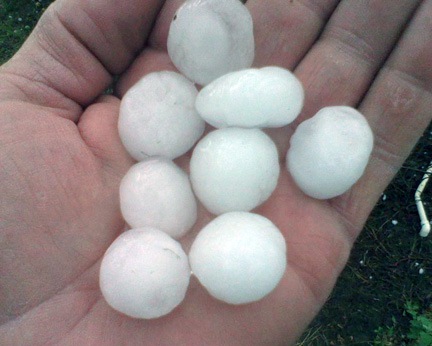
This hail fell in Prosser, WA this morning. So glad it didn’t fall anywhere near my helicopter.
Right now, it’s cloudy outside, with thunderstorms rolling through the area. Ron dried an orchard in Quincy 1-1/2 times. (It started raining when he was half finished so he waited it out and restarted.) I’ve been watching severe storms moving northeast through the area mostly east of me. A severe storm passed over Lake Chelan at Manson near where my friend Jim is based with his helicopter. One of my growers sent me a photo of hail the size of…well, the size of cherries… that fell in the Prosser area. Hail like this can destroy a helicopter, so I’ll be covering mine up in case any storms like that pass through here.
Will I fly today? Who knows? In all honesty, I hope I don’t.
I’d like a rest — and I’m sure my clients would, too.
Postscript, 30-June-2013
Two things I’d like to mention.
Nick Henderson put this video of his cherry drying work on YouTube. Check it out.
First, I wound up flying another 5 hours on Saturday, drying a total of 208 acres. The rain came down fast and furious, with thunderstorms rolling through and flash flood warnings for Wenatchee. More than an inch of rain fell near where I’m based.
Second, fellow cherry drying pilot Nick Henderson put together this little video of his cherry drying work this week if you want to see what it looks like from the pilot’s point of view.
Today (Sunday) is a beautiful clear day — perfect for a well-deserved day off!

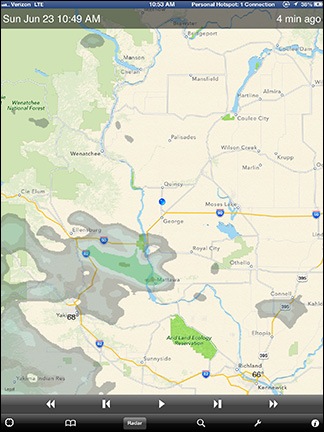

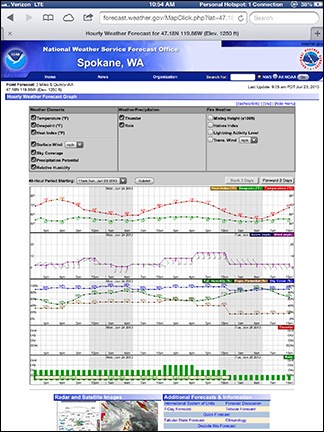
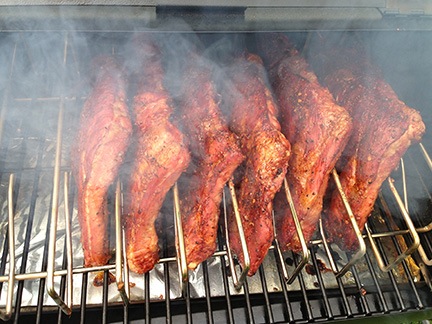

 When I returned, I found the fan scroll cowl covered with cloth that turned out to be two old coveralls. I pulled them off to find a mess in the back end of the helicopter. Birds had flown between the fins on the fan scroll cowl (consult photo above) and had brought all kinds of hay and twigs. They’d left nesting materials inside the cowl and inside the fan itself. And there was a ton of bird poop.
When I returned, I found the fan scroll cowl covered with cloth that turned out to be two old coveralls. I pulled them off to find a mess in the back end of the helicopter. Birds had flown between the fins on the fan scroll cowl (consult photo above) and had brought all kinds of hay and twigs. They’d left nesting materials inside the cowl and inside the fan itself. And there was a ton of bird poop. When I was satisfied all the nesting material was out and the cowl was as clean as I’d get it, I put it all back together. Then I used plastic bags to cover up the fins so birds couldn’t fly back in there. That would have to protect it until I flew again.
When I was satisfied all the nesting material was out and the cowl was as clean as I’d get it, I put it all back together. Then I used plastic bags to cover up the fins so birds couldn’t fly back in there. That would have to protect it until I flew again. I was gone about 45 minutes. (I admit I also stopped at Dairy Queen for a chocolate shake.) When I returned with the oil, I saw a bird nest, complete with pale blue eggs, on the floor in the hangar.
I was gone about 45 minutes. (I admit I also stopped at Dairy Queen for a chocolate shake.) When I returned with the oil, I saw a bird nest, complete with pale blue eggs, on the floor in the hangar.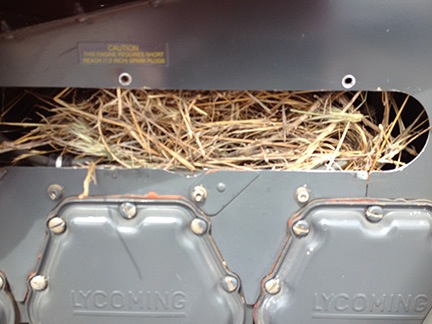 “I got a picture of it,” he told me. On his phone, he showed me a photo of the engine with hay stuffed into the area on top of it.
“I got a picture of it,” he told me. On his phone, he showed me a photo of the engine with hay stuffed into the area on top of it.
